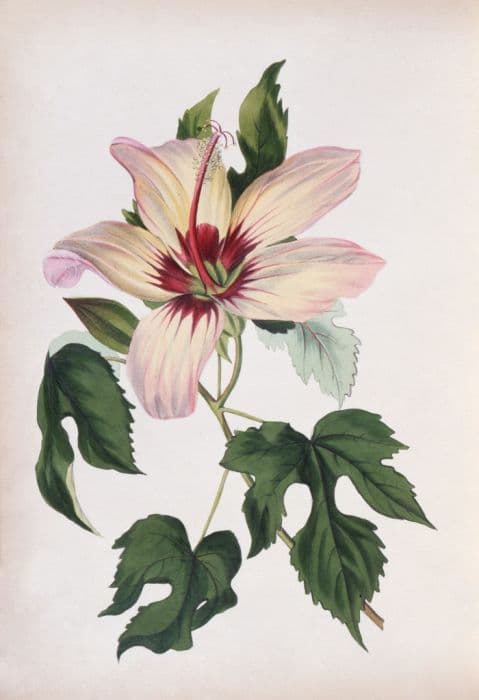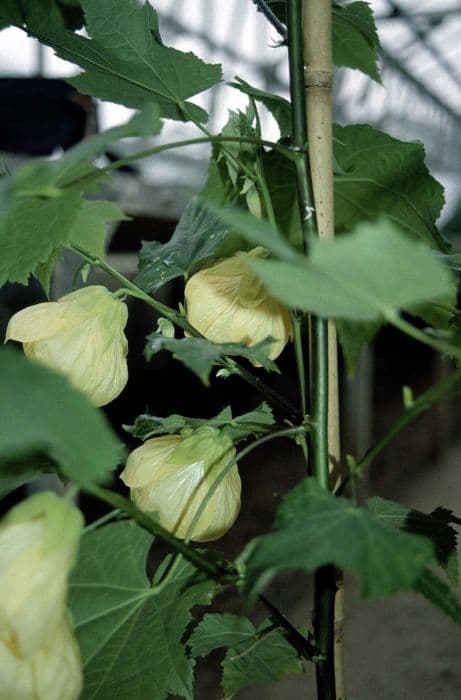Flowering Maple Abutilon 'Orange Glow' (v)

ABOUT
Abutilon 'Orange Glow' is a visually striking plant, most notable for its beautiful, bell-shaped flowers with a vibrant orange color that seem to illuminate the plant as if it carried its own warm light. The flowers dangle delicately from the branches, resembling glowing lanterns hanging from a finely crafted chandelier. The foliage of this plant forms a lush backdrop for its radiant blooms with heart-shaped leaves that have a somewhat velvety texture and are a rich green in hue. These leaves often display pronounced veins adding to the textural interest of the plant. Though specific measurements are omitted, the overall form is full and somewhat rounded, implying a bushy habit that provides plenty of foliage and blooms for onlookers to enjoy. The contrast between the orange flowers and green leaves creates a compelling display that is sure to catch the eye in any setting.
About this plant
 Names
NamesFamily
Malvaceae.
Synonyms
Flowering Maple, Chinese Lantern, Parlour Maple, Indian Mallow.
Common names
Abutilon 'Orange Glow'
 Toxicity
ToxicityTo humans
The Flowering Maple, commonly referred to as Abutilon 'Orange Glow', is not known to be toxic to humans. Consequently, ingestion of this plant typically does not result in poisoning or adverse health effects. However, it's always prudent to exercise caution and avoid ingesting plants not meant for consumption, as individual sensitivities can vary.
To pets
The Flowering Maple, or Abutilon 'Orange Glow', is generally considered non-toxic to pets such as dogs and cats. There should be no toxic symptoms associated with the ingestion of this plant by pets. Nevertheless, ingestion of non-food plants can sometimes cause mild gastrointestinal upset in sensitive animals, so it's wise to monitor pets and keep houseplants out of their reach.
 Characteristics
CharacteristicsLife cycle
Perennials
Foliage type
Semi-deciduous
Color of leaves
Green
Flower color
Orange
Height
3-4 feet (0.91-1.22 meters)
Spread
2-3 feet (0.61-0.91 meters)
Plant type
Shrub
Hardiness zones
9
Native area
South America
Benefits
 General Benefits
General Benefits- Attractive Blooms: 'Orange Glow' produces vibrant orange flowers that add a pop of color to any garden space.
- Extended Flowering Season: It often has a long blooming period that extends through multiple seasons.
- Easy to Grow: This plant is known for being easy to cultivate, requiring minimal expert care to thrive.
- Drought Tolerant: Once established, it can tolerate dry conditions, making it suitable for water-wise gardens.
- Wildlife Attraction: The colorful flowers can attract pollinators such as bees and hummingbirds, enhancing biodiversity.
- Fast Growing: It's a fast grower, which can provide quick coverage or fill in garden spaces efficiently.
- Adaptable: Able to grow in a variety of soil types as long as they are well-draining.
- Decorative Foliage: The plant has attractive heart-shaped leaves that provide visual interest even when it's not in bloom.
- Versatile Usage: Suitable for use in beds, borders, containers, and as a specimen plant.
- Temperature Tolerance: Can tolerate a range of temperatures, making it suitable for different climates.
 Medical Properties
Medical PropertiesThis plant is not used for medical purposes.
 Air-purifying Qualities
Air-purifying QualitiesThis plant is not specifically known for air purifying qualities.
 Other Uses
Other Uses- Craft Material: Dried stems and seedpods of the Flowering Maple can be used in floral arrangements and other craft projects for their intriguing texture and shape.
- Photography Subject: With its vibrant orange flowers, the Flowering Maple is an excellent subject for photographers looking to capture the beauty of plants in their work.
- Education: The Flowering Maple can be used in educational contexts to teach about pollination and the growth habits of shrubs.
- Habitat Support: The Flowering Maple can provide shelter and nesting materials for small birds and insects in the garden ecosystem.
- Seasonal Decoration: Branches and flowers of the Flowering Maple can be used for creating seasonal wreaths and table centerpieces.
- Fabric Dye: The flowers and leaves might be used to produce natural dyes for fabrics, though this is not a common use.
- Privacy Screening: When planted in a row or a hedge, Flowering Maple can provide a natural and colorful screen for privacy in gardens and patios.
- Artistic Inspiration: The Flowering Maple's striking appearance serves as inspiration for artists and designers seeking organic shapes and colors for their work.
- Leaf Castings: The large, uniquely shaped leaves can be used to make concrete or plaster castings for decorative garden stepping stones or art pieces.
- Symbolic Gift: As a symbol of warmth and radiance due to its color, a Flowering Maple plant can be given as a gift to represent happiness and creativity.
Interesting Facts
 Feng Shui
Feng ShuiThe Flowering Maple is not used in Feng Shui practice.
 Zodiac Sign Compitability
Zodiac Sign CompitabilityThe Flowering Maple is not used in astrology practice.
 Plant Symbolism
Plant Symbolism- Warmth and Energy: The 'Orange Glow' in the common name suggests a symbol of vitality and enthusiasm, much like the warm and radiant sun.
- Optimism and Positivity: Orange is often associated with positivity and cheerfulness, making this plant a symbol of an optimistic outlook and the spreading of positive vibes.
- Encouragement: With its bright orange blooms, the plant can symbolize encouragement and support, inspiring people to stay motivated and proceed with confidence.
- Creativity: Abutilon 'Orange Glow' might also be linked with creativity and inspiration, as the color orange is often connected to creativity and artistic expression.
- Warmth in Relationships: The warm color of its flowers can symbolize a friendly disposition and warmth in personal relationships, denoting a caring and nurturing personality.
- Attention and Focus: The vividness of the orange color in the flowers may also represent the need for focus and the ability to attract attention, highlighting the importance of being seen and heard.
 Water
WaterFor the Flowering Maple, which is the common name for Abutilon 'Orange Glow', water thoroughly when the top inch of soil feels dry to the touch. This usually means you should water approximately every 7 to 10 days, but the frequency can vary depending on light and temperature conditions. Ensure you provide enough water to reach the roots, using roughly 1-2 gallons for a medium-sized plant every time you water, and allow excess water to drain away to prevent root rot.
 Light
LightThe Flowering Maple flourishes in bright, indirect light. A spot near an east or west-facing window where it can receive some direct sunlight in the morning or late afternoon is ideal. However, avoid placing it in full direct sunlight during peak hours to prevent leaf scorch.
 Temperature
TemperatureThe Flowering Maple prefers a temperate range of 60 to 75 degrees Fahrenheit. It can survive minimum temperatures down to about 50 degrees Fahrenheit but should not be exposed to temperatures below this as it may cause harm. Ideally, keep it in an environment that consistently stays within the preferred temperature range for optimal growth.
 Pruning
PruningPrune the Flowering Maple annually to maintain its shape and encourage bushier growth. The best time for pruning is early spring, before new growth begins. Cut back leggy stems and remove any dead or damaged growth. This should be done carefully to not remove more than one third of the plant at a time.
 Cleaning
CleaningAs needed
 Soil
SoilThe Chinese lantern (Abutilon 'Orange Glow') thrives in rich, well-draining soil. A mixture of peat, pine bark, and perlite or sand in equal parts is ideal. The soil pH should be mildly acidic to neutral, ranging from 6.0 to 7.5 for optimal growth.
 Repotting
RepottingChinese lanterns should be repotted every 2-3 years to refresh soil and accommodate root growth. Spring is the best time to repot, giving the plant a chance to recover during its active growing season.
 Humidity & Misting
Humidity & MistingChinese lanterns prefer moderate to high humidity levels, around 50-60%. They can tolerate lower humidity but may need regular misting to maintain leaf health and vigor.
 Suitable locations
Suitable locationsIndoor
Keep in bright, indirect light and prune regularly.
Outdoor
Plant in partial shade and shelter from strong winds.
Hardiness zone
9-11 USDA
 Life cycle
Life cycleThe life of Abutilon 'Orange Glow', commonly known as Flowering Maple, begins with germination where a seed sprouts and develops a root system and initial leaves under appropriate temperature and moisture conditions. This is followed by the vegetative stage, where the plant experiences rapid growth of foliage and stems, preparing for flowering. During the flowering stage, the plant produces its characteristic bright orange, bell-shaped flowers, which attract pollinators and are key for reproduction. Following pollination, the flowers develop into fruit, which are capsules containing seeds. The seeds reach maturity and, once released, can be dispersed to begin a new life cycle. Lastly, in temperate regions, Abutilon 'Orange Glow' may enter a dormancy period during colder months and then regrow from its semi-woody base with the return of favorable conditions.
 Propogation
PropogationPropogation time
Spring-Early Summer
The Flowering Maple 'Orange Glow,' commonly known as Abutilon 'Orange Glow', is often propagated during the warmer months when the plant is actively growing. The most popular method of propagation for this plant is through stem cuttings. To propagate with this method, a healthy stem tip approximately 4 to 6 inches (about 10 to 15 centimeters) long is cut from the parent plant. It's important to make the cut just below a leaf node and to remove the lower leaves. The cut end of the stem should then be dipped in rooting hormone powder to encourage root development and planted in a pot filled with a well-draining soil mix. The soil around the cutting should be gently firmed and watered, and the pot should be placed in a warm, bright location out of direct sunlight. A plastic bag can be used to cover the pot to maintain humidity, which helps the cutting take root more effectively.









